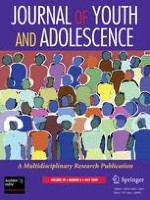01-07-2009 | Empirical Research
Anxiety Trajectories and Identity Development in Adolescence: A Five-wave Longitudinal Study
Gepubliceerd in: Journal of Youth and Adolescence | Uitgave 6/2009
Log in om toegang te krijgenAbstract
The aim of this five-wave longitudinal study was to investigate the relationship between anxiety and adolescent identity development. Participants were 1,313 adolescents who annually completed measures of anxiety and identity. Growth Mixture Modeling (GMM) analyses demonstrated that the adolescent population was best typified by two latent growth trajectory classes: a low anxiety class (n = 1,199) characterized by a low initial level of anxiety that decreased over time and a high anxiety class (n = 114) characterized by a higher initial level of anxiety that increased over time. To answer our research question, we tested a model in which the anxiety classes predicted initial levels and rates of change of three identity dimensions: commitment, in-depth exploration, and reconsideration of commitment. Findings indicated that the high anxiety adolescents displayed a more troublesome identity development than their low anxiety peers, since their commitments became weaker with age, and they reconsidered them intensively.
